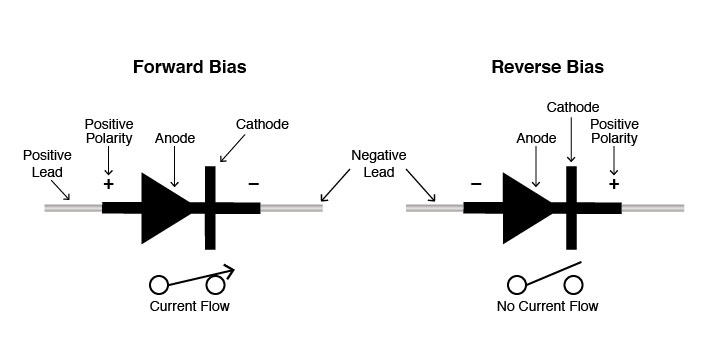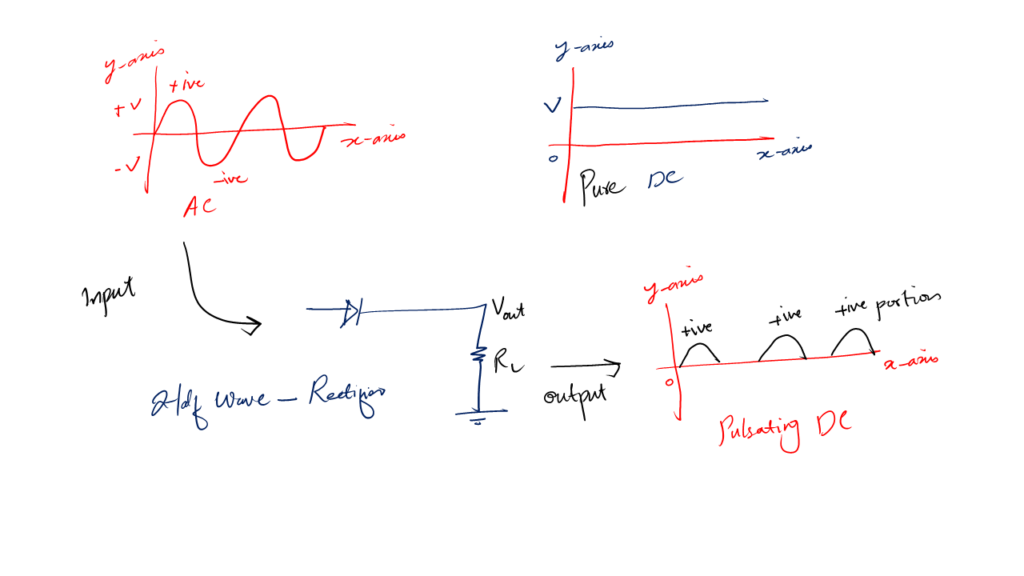The electronic component that allows the flow of current in one direction and block in another direction is a diode. There are various functions of a diode in a circuit.
The diode is a switching device. The functions like rectification, reverse current protection, overvoltage clamping, signal modulation, switching, and temperature measurements a diode can perform in a circuit. There are also some special types of diodes like light-emitting diodes which perform specific functions.
In this article, we are going to talk about the diode functions in a circuit and will explain each function in detail for better understanding.
Diode Functions in Circuit
You know, a diode is a two-terminal passive electronic device that allows the flow of current only in forward bias mode.
In forward bias mode, we connect the positive terminal of the voltage source to the anode of the diode and the negative terminal of a voltage source to the cathode of a diode.
In this configuration, the current can pass through the diode to the rest of the circuit.
The opposite of this operation is the reverse bias mode. In this mode, the diode doesn’t allow any flow of current.
If you see closely we will see, that a diode is nothing but a digital switch when turns ON in forward bias and turn OFF in reverse bias.

Now, this simple switching property gives us a lot of useful applications in the circuit. I can say that today’s modern world is possible because of this simple yet effective switching phenomenon.
Let’s see diode functions and applications in any electronics or electrical circuit.
1- As a digital switch
Diodes are used in circuits for switching purposes. We can call them the digital switches. The main reason why it is used as a switch is that you can turn it ON and OFF automatically just by providing the right voltages.
Secondly, its switching speed is faster than a traditional switch. Also, it is very small and low cost as well.
Because of its small size, we can save a lot of circuit space thus making the smart and portable devices possible.
2- Handling high power signals
Power electronics is a big sub-field of electronics. In power electronics, we work with high voltage, current, and power signals.
For power to be efficiently handled we need low-loss switches. And thus diodes come into play.
As a switch diode can handle power signals from mW up to KW depending upon the application. A signal can be of voltage or current, or their product.
3- Safety
The diode doesn’t all the flow of current in reverse bias mode, i.e. when a negative signal is given. So we use it to protect our circuit from negative unwanted signals.
4- Half wave rectification
You know, most of the electronics devices we use today or work with – all work on DC voltages. But the main voltages coming to our homes, schools, or industry are AC.
The reason why AC is used for long distances is that it has very low heat losses as compared to DC. But we can’t store AC that is why we need to convert them to DC. So that we can store it in batteries.
Diodes are used to perform such the above required action. They convert AC into DC. And this one of the key diode functions has made this modern electronics world possible.
Now, AC has two portions. The positive and the negative portion. These portions are alternating (changing) with time and that is why such signals are called alternating current (AC).

While DC (direct current) is unidirectional, i.e. it does not have any alternating portions.
You see, as we learned above a diode blocks current in reverse bias meaning if a negative portion of the signal is applied to it – the diode will block it.
So, to convert AC into DC we need to block the negative portion – and that is where we use diodes.
In short summary, one key function or role of the diode in an electronics circuit is to convert AC into DC.
5- Full wave rectification
Full wave rectification is the same as the above half wave rectification except for a few simple reasons.
To simply clarify – Full wave rectification is the process of converting AC in to DC.
Full wave rectifiers do the said more efficiently than the half wave rectifiers. But it uses more diodes than the half rectifier. In a half rectifier, we need only one diode. While for a full rectifier we need four diodes.
We can arrange four diodes manually, and we can also buy them in a solo package called the rectifier bridge.
You know, this full wave rectifier is the core part of any power supply. Now you can imagine that we need a power supply for every device. There are no such devices that don’t need a power supply.
So in short, the diode is what we need for almost all of our electronics device’s proper operations.
6- Voltage multipliers
Sometimes we need higher voltage levels for various reasons depending on the project or application we are working on.
One way is that we design battery sources with that high voltage levels. But designing such a battery is very costly, bulky, and not a proper option for working with smart modern day electronics.
Like imagine a bulky device these days – no one will appreciate it. And that is we need a much better solution.
So, in applications where higher voltage levels are required we use a diode to multiply the given voltages to double, or quadruple levels keeping the size of the circuit the same and unaffected.
7- Signal clampers
One of the key diode functions in the circuit is that we can use it to clamp a signal to our required levels without distorting the original information in the signal.
Clamping a signal means adding DC value to it. Now, you can add positive DC as well as negative DC depending on what you are designing.
Imagine you have a sine signal on the x-axis of a Cartesian coordinate system. Now you want to just move that signal on Y-ais with a value of let’s say 3.
To perform such an operation in a given electronics circuits we use diodes. Diodes help us to add that 3 to that sine signal.
We need this addition for a few reasons. One of the main reasons is – to use that added DC to power up the device which will use this signal. So that we don’t have to put a separate power supply there just to power that device – thus saving us a lot of money and circuit space.
You can see now that a simple diode has so many key functions in almost every electronic device, circuit, or even industry-level system.
8 – Signal clippers
Signal clipping means removing a portion of a signal. The portion can be positive or negative depending on what you are designing.
Imagine you have a system that works in a certain range of voltage amplitude. Let’s say the maximum voltage level it can bear is 0.5V.
If your given signal reaches that threshold you may end up damaging that system. To avoid such a situation diodes come into play. They clip the signals when they exceed that bearable threshold.
So signal clipping is one of the key diode functions in circuits. It is used mostly for safety and protection purposes.
9- Freewheeling
When we have loads where there is a chance of current flowing back into the circuit we use a diode to block that current flow. The diodes used for such tasks are called freewheeling diodes.
The back flow current can damage or null function our circuits. This usually happens when we have inductive loads or when we are working with motors.
10- Voltage regulations
Voltage regulation means a constant output voltage regardless of the current flow or load variations.
It is a very important parameter to look for when buying any kind of voltage source. If your voltage source output is not constant for a given range of loads.
You have a terrible voltage source that will degrade the function of any device which uses it for its operations.
Luckily, voltage regulation is the basic function of a diode in power supply circuits.
The diode used for such operation is called zenor diode – a type of diode.
11- Signal peak detection
As the heading suggests. We use a diode for the detection of signal peaks. The peak of a signal is the most important information to look for. It helps to design things or circuit portions in regard to those peaks we get from the input signals.
12- Envelope Detector
You know, these communications devices which we use most of the day are electronic devices that work on Radio Frequencies waves or sometimes millimeter waves.
Now the information these signals carry is in the form of envelopes. By envelope, I mean there is a message signal modulated with the carrier signal.
And diodes are key components that help us detect those message envelopes sent from the transceiver of the signal.
13- RF variable attenuator
You know, by changing the bias current through a PN diode, it’s possible to change the RF resistance.
At high frequencies, the diode appears as a resistor whose resistance is an inverse function of its forward current. In addition, a diode can be used in some variable attenuator designs as amplitude modulators or output leveling (automatic gain control) circuits.
These are some diode functions in circuit to helps in understanding diode functionality.
Conclusion
A diode is a very fundamental electronics component. It has two terminals in most cases and acts as passive elements.
The main property of a diode is, that when it is forward bias it allows the current flow. In reverse bias, there is no current flow.
Using the above property we can say a diode is like a switch. It turns ON in forward bias case and turns OFF in reverse bias case.
And this switch property makes a diode a very special component in the field of electronics. Most diode functions in the circuit are only possible because of this single property.
In this article, I share my limited knowledge about some of the key roles that a diode plays in almost every circuit. Following is a quick summary of some common diode functions.
We can use a diode for:
- Switching
- Handling high power signals
- Safety
- Half wave rectification
- Full wave rectification
- Voltage multipliers
- Signal Clampers
- Signal Clippers
- Freewheeling
- Voltage regulations
- Signal peak detection
- Envelope Detector
- RF variable attenuator
We use diodes for switching especially for fast recovery time. We use them to handle high power signals in power electronics projects.
Not just that, AC to DC conversion is possible because of diodes. Voltage multipliers are most widely used in a lot of applications – thus saving us a lot of money and circuit space.
Sometimes we need to cancel out some portion of a signal and sometimes we want to add DC into our signals. This is one of the key operations of a diode. This process is called signal clipping and clamping.
Moreover, a constant voltage is always required at the power source output. We don’t want a power source or voltage source that varies its voltages as there comes slides variation in the load values due to heat or other environmental factors.
There are a lot of functions of diodes in communication and RF circuits as well. We use a diode in such circuits for signal peak and envelope detection.
So, that is it.
That’s all I have about diode functions in a circuit. I hope you enjoyed it.
Thank you and stay blessed…
Other useful posts:
